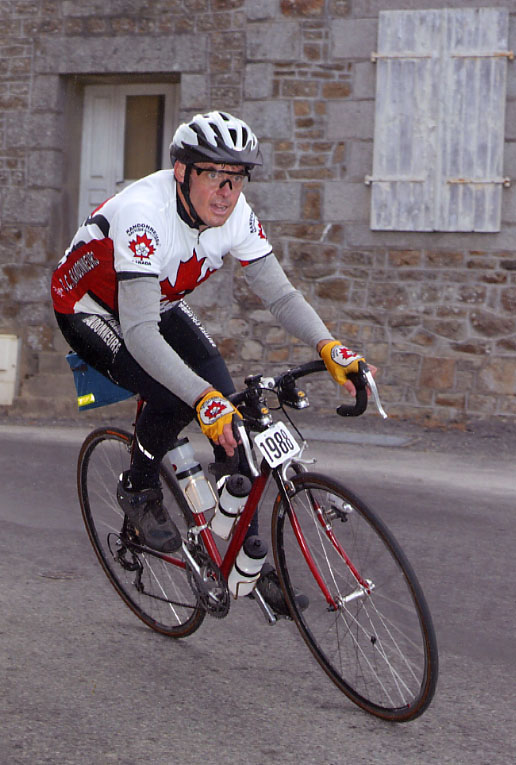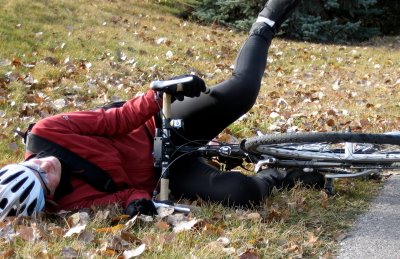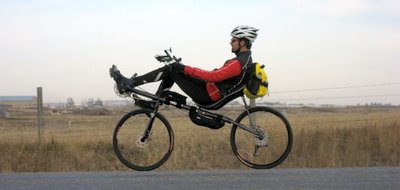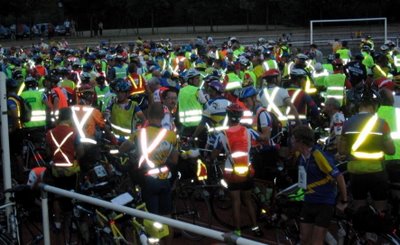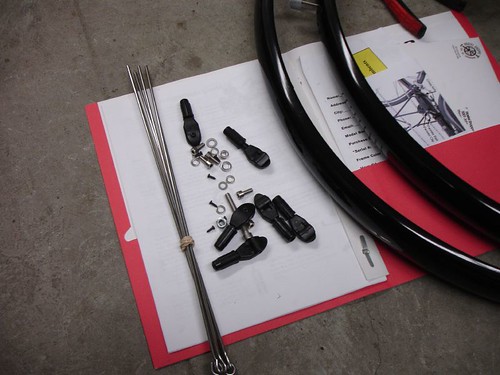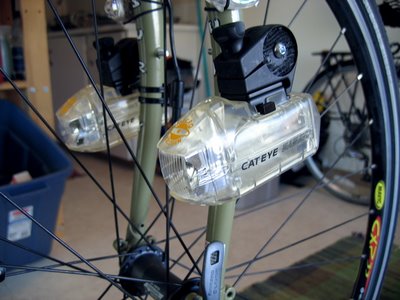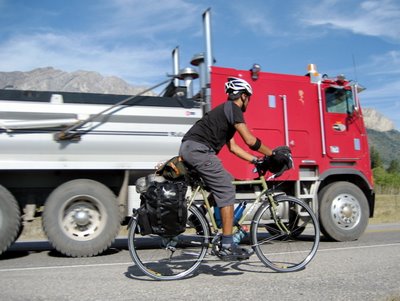The Competitive Side of Randonneuring
By Jan Heine and Melinda Lyon
In 2003, the awards ceremony after Paris-Brest-Paris for the first time ignored the fastest male riders. While these riders had ridden faster than any randonneurs in PBP history, they were penalized two hours for various infractions of the rules. One of the officials, Gilbert Bulté, lists the transgressions: "Pushing officials at a control, urinating in towns, running numerous red lights and stop signs, being illuminated by an illegal support car, refusing to let my car pass, disrespect when I identified myself as an official." Robert Lepertel, the organizer of PBP, wrote in the newsletter of the French Cyclotouring Federation: "Never before have so many spectating cyclists and participants felt so compromised by this disrespect of the rules. The first 12 or 15 [...] have no respect for the organizers, the officials and all who make PBP a celebration of perseverance in the quest to complete this difficult ride. They do not deserve the name randonneur, as they do not know what riding unsupported means." (Cyclotourisme No. 518, 10/2003, p. 34.)
Strong words indeed, especially since the riders penalized did not feel that they did anything wrong or extraordinary. While they might not have followed every rule in the book, they felt that they had behaved as one would during a bicycle race. On the other hand, the organizers said that not only individual infractions had led to the penalty, but the spirit of the first riders evident from their disrespect of the rules. Clearly, there was a disconnect between the first riders and the organizers, about what PBP represents.
The organizers strongly feel that PBP is not a race, and that the spirit of randonneuring is threatened by these riders' behavior. But what is the spirit of randonneuring? The rules of PBP provide little guidance on this subject. BRM rules simply state that "brevets are not competitive events" (Article 12). But why is the time of each finisher listed, and why do the organizers of PBP recognize records and award trophies to those who are the fastest in their category? Doesn't that mean that it is race after all, for those who want to go fast? One can see why people might choose to disregard other rules as well in their quest to come first.
To examine this apparent contradic- tion between "not competitive" and awards for fastest riders, one has to look at the history of Paris-Brest-Paris. In 1931, randonneurs joined PBP, which had been a professional race since 1891. In the 1950s, all the other professional races were getting shorter. With the rather different training required for PBP, it no longer made sense for racers to bank a whole season on an elusive PBP win. PBP as a professional race died. The randonneurs took up the challenge.
Unlike the racers, who earned a living from the bike, the randonneurs rode for fun. They were proud to be amateurs -- lovers of cycling. The randonneurs were quite com- petitive at times (there is the Audax event for those who want non-competitive riding), but it was an amicable com- petition for the most part. Many of them remained involved in the sport for the rest of their lives, either as participants (the fastest sin- gle bike rider in 1956, Roger Baumann, went on to ride a record 10 PBP) or volunteers. In fact, Gilbert Bulté, the above-mentioned official, was on one of the two tandems that tied for first in 1956, beating all the single bikes. Roger Baumann, the aforementioned record-holder, was volunteering at Villaines-la-Juhel this year. The organizer of PBP 2003, Pierre Theobald, also com- peted in the late 1950s in various randonneur events.
Clearly, the organizers of PBP understand competition, and yet they don't see PBP as a race. The difference is subtle, and it has to do with civility. While racing is more like a battle, with only one rider coming out as a winner, randonneuring is all about the civilized enjoyment of cycling. Or as a non-randonneuring friend once put it: It is the quest for the perfect cyclist, any distance, any weather, self-sufficient.
This does not mean you have to go slow, or that you cannot be competitive. After all, PBP is about performance: You only get a medal if you finish within the time limit. For many riders, that means riding at the limit for up to 90 hours! And there is nothing wrong with challenging yourself and trying to better your previous times. Or even with trying to ride faster than others. But the important fact remains: Every finisher of PBP is a winner. Someone may be the fastest rider, even get a trophy, but they cannot claim to have "won" PBP. Everybody receives the same medal. The spectators understand this, and if anything, cheer on the last finishers more than the first ones.
The difference to racing is clear: Races defer to the fastest riders. By definition, potential winners of a race are more important than other riders. If a slower rider gets lapped in a circuit race, at the very least, they are expected to get out of the way of the faster riders, if they aren't pulled out of the race entirely. In a randonneur event, every participant is equally important. Fast riders cannot expect slower ones to make way for them at controls. Even the fastest are expected to behave in a civil and polite manner toward other participants, spectators and officials.
Randonneuring also is about self-sufficiency. Even though support cars are allowed at controls - mostly because it would be difficult to enforce a ban! - riders are expected to be able to ride by themselves, and to be prepared for the challenges of the road ahead.
Just as racing has its own ethics, such as frowning upon attacks when somebody has a flat or during a "neutral" bathroom stop, randonneuring does, too. These rules are unwritten, and different people may see them differently. Here is our take:
- Most of all, be polite, which means being considerate of others. While raw aggression has a place in racing, it does not in randonneuring. Try to be an ambassador for cycling, for your club and for your country.
- If you have ridden in a small group for a while, and if everybody has been sharing the work, try to finish together. This should include stopping for flat tires (unless one rider has multiple flats because they ride old tires or stupid equipment).
- Attacks are not part of the sport. If somebody gets dropped because they cannot follow the pace, so be it. But sudden accelerations to rid yourself of fellow riders are not polite. That is why there is no finishing sprint: All riders of a group are classified the same and get the same time. (In a race, the need to declare one winner leads to complex equipment and difficult decisions to determine exactly who crossed the line first, if only by half an inch.)
- Avoid putting yourself in an "irregular situation." Follow the rules of the event. This means respecting the rules of the road: Obey stop signs and red lights. Ride only with riders who are participants. If there is a car following your group for an extended period of time, especially at night, something is wrong. If there are official follow cars of the PBP organizer, they will drive with only their parking lights on, to avoid giving an advantage to the first riders. If you find yourself in the company of an illegal support car, ride ahead or drop behind, but don't stay with an illegal group. While it is hard to give up the advantage of a group, consider that if you are caught, the penalties will more than outweigh the time gained by riding with the group.
- Be friendly to volunteers and officials. Follow their orders. Thank them for their time. This takes only a second or two. Without them, you would not be riding in this wonderful event.
- Finish the event! The goal is to do the best ride possible under the circumstances. To ride fast and then to drop out because you cannot achieve your time goal is the ultimate failure.
Of course, this spirit applies not only to PBP, but to randonneuring in general. Have fun, go fast if you like, challenge yourself and others, but remember: It is not a race!
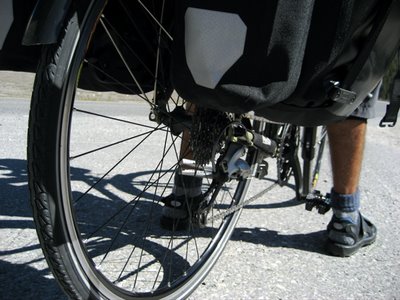 Things will be quiet around here for the next month. I am off to Baja to cycle the Trans-peninsular Highway. Camping in the desert, drinking Pacificos, eating tacos and the most amazing sunrises & sunsets - yes the daunting challenges of the Baja Randonneur Training Camp.
Things will be quiet around here for the next month. I am off to Baja to cycle the Trans-peninsular Highway. Camping in the desert, drinking Pacificos, eating tacos and the most amazing sunrises & sunsets - yes the daunting challenges of the Baja Randonneur Training Camp.





